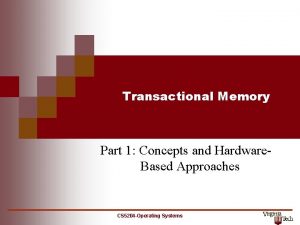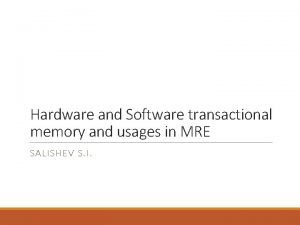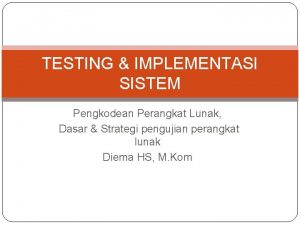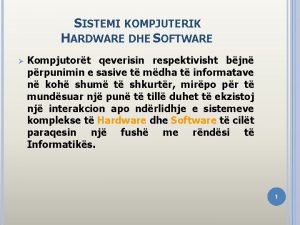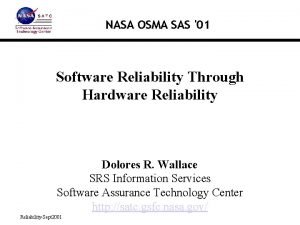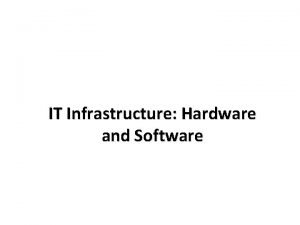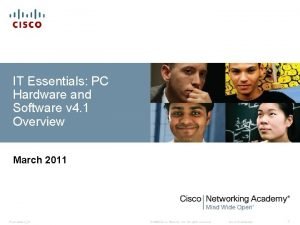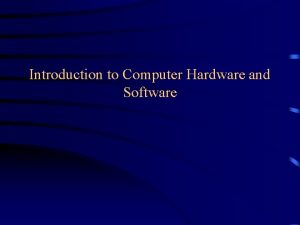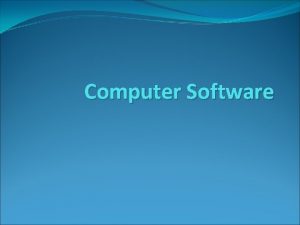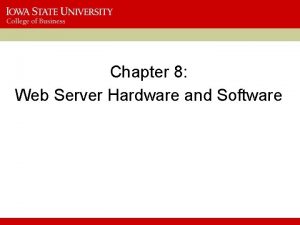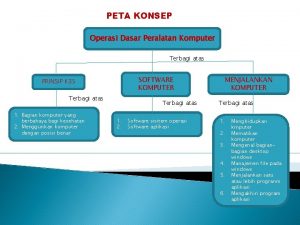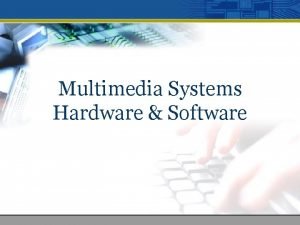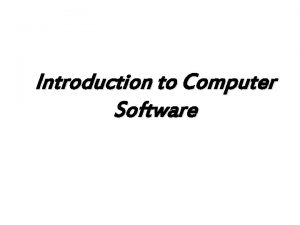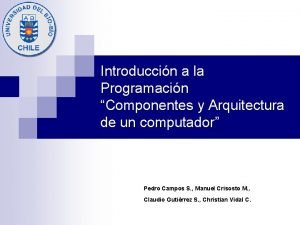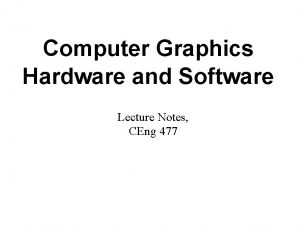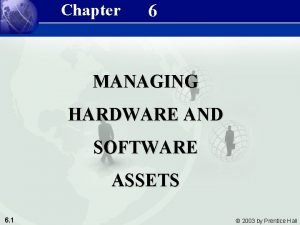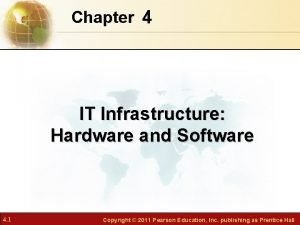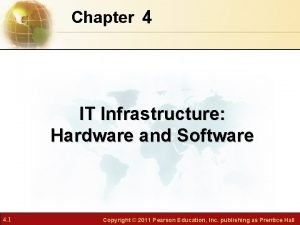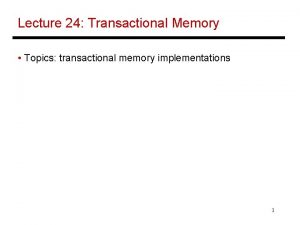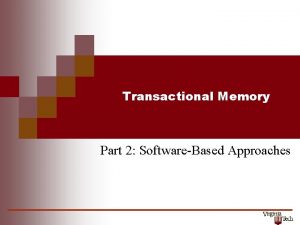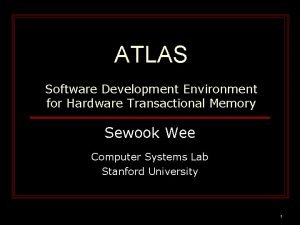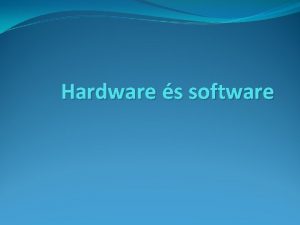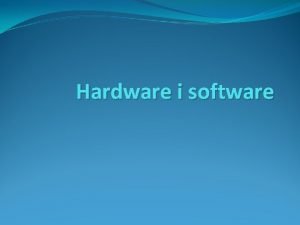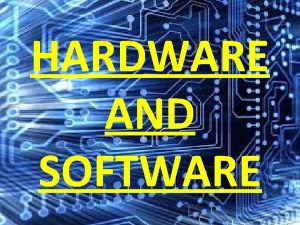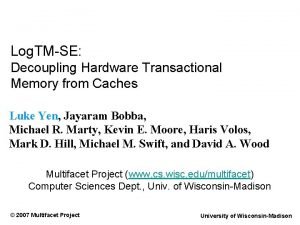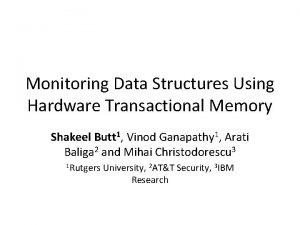The Case for Hardware Transactional Memory in Software











































- Slides: 43

The Case for Hardware Transactional Memory in Software Packet Processing Martin Labrecque Prof. Gregory Steffan University of Toronto ANCS, October 26 th 2010

Packet Processing: Extremely Broad Our Focus: Software Packet Processing Where Does Software Come into Play? Home networking Edge routing Core providers 2

Types of Packet Processing Basic Byte-Manipulation Control-Flow Intensive Switching and routing, port forwarding, port and IP filtering Cryptography, compression routines deep packet inspection, virtualization, load balancing Crypto Core 200 MHz MIPS CPU 5 port + wireless LAN Key & Data P 0 P 1 P 2 P 3 P 4 P 5 P 6 P 7 P 8 Many software programmable cores Control-flow intensive & stateful applications 3

Parallelizing Stateful Applications Most packets access and modify data structures Map those applications to modern multicores: how? Thread 1 Thread 2 Thread 3 Thread 4 Packet 1 Packet 2 Packet 3 Packet 4 Ideal scenario: TIME Packets are dataindependent and are processed in parallel Reality: TIME Programmers need to insert locks in case there is a dependence wait How often do packets encounter data dependences? 4

Fraction of Dependent Packets Fraction of Conflicting Packets Packet Window UDHCP: parallelism still exist across different critical sections Geomean: 15% of dependent packets for a window of 16 packets Ratio generally decreases with higher window size / traffic aggregation 5

Stateful Software Packet Processing 1. Synchronizing threads with global locks: overly-conservative 80 -90% of the time 2. Lots of potential for avoiding lock-based synchronization in the common case 6

Could We Avoid Synchronization? Single Pipeline Array of Pipelines Application Thread Pipelining allows critical sections to execute in isolation What is the effect on performance given a single pipeline?

Pipelining is not Straightforward Normalized variability of processing per packet (standard deviation/mean) Difficult to pipeline a varying latency task Imbalance of pipeline stages (max stage latency / mean) after automated pipelining in 8 stages based on data and control flow affinity High pipeline imbalance leads to low processor utilization 8

Run-to-Completion Model • Only one program for all threads Programming and scaling is simplified Challenge: requires synchronization across threads Flow affinity scheduling: could avoid some synchronization but not a 'silver bullet' 9

Run-to-Completion Programming void main(void) { Many threads execute main() while(1) { char* pkt = get_next_packet(); process_pkt(); send_pkt(pkt); } Shared data is protected by locks } Manageable, but must get locks right! 10

Getting Locks Right SINGLE-THREADED MULTI-THREADED packet = get_packet(); … … connection = database->lookup(packet); connection = database->add(packet); Atomic if(connection == NULL) connection = database->add(packet); connection->count++; … … global_packet_count++; Atomic connection->count++; global_packet_count++; Challenges: 1 - Must correctly protect all shared data accesses 2 - More finer-grain locks improved performance 11

Opportunity for Parallelism MULTI-THREADED packet = get_packet(); … connection = database->lookup(packet); if(connection == NULL) connection = database->add(packet); connection->count++; Atomic No Parallelism Atomic Optimisic Parallelism across Connections … global_packet_count++; Control-flow intensive programs with shared state Over-synchronized 12

Stateful Software Packet Processing 1. synchronizing threads with global locks: overly-conservative 80 -90% of the time 2. Lots of potential for avoiding lock-based synchronization in the common case POINTER ACCESS CONTROL FLOW e. g. : Lock(A); if ( f(shared_v 1) ) shared_v 2 = 0; Unlock(A); Lock(B); shared_v 3[i] ++; (*ptr)++; Unlock(B); Transactional Memory! 13

Improving Synchronization Locks can oversynchronize parallelism across flows/connections Transactional memory – simplifies synchronization – exploits optimistic parallelism 14

Locks versus Transactions LOCKS Thread 1 Thread 2 Thread 3 Thread 4 USE FOR: true/frequent sharing TRANSACTIONS Thread 1 Thread 2 Thread 3 Thread 4 x infrequent sharing Our approach: Support locks & transactions with the same API! 15

Implementation 16

Our Implementation in FPGA Ethernet MAC DDR controller Processor(s) Soft processors: processors in the FPGA fabric Allows full-speed/in-system architectural prototyping Many cores Must Support Parallel Programming 17

Our Target: Net. FPGA Network Card – Virtex II Pro 50 FPGA – 4 Gigabit Ethernet ports – 1 PCI interface @ 33 MHz – 64 MB DDR 2 SDRAM @ 200 MHz 10 x less baseline latency compared to high-end server 18

Net. Threads: Our Base System Synch. Unit processor 4 -threads processor I$ 4 -threads I$ Instr. Data Input mem. Output mem. packet input Input Buffer Data Cache Output Buffer packet output Off-chip DDR 2 Program 8 threads? Released online: Write 1 program, run on all threads! netfpga+netthreads 19

Net. TM: extending Net. Threads for TM Synch. Unit Conflict Detection processor 4 -threads processor I$ 4 -threads I$ Instr. Data Input mem. Output mem. Undo. Log packet input Input Buffer Data Cache Output Buffer packet output Off-chip DDR 2 - 1 K words speculative writes buffer per thread - 4 -LUT: +21% 16 K BRAMs: +25% Preserved 125 MHz 20

Conflict Detection • Tracking speculative reads and writes • Compare accesses across transactions: Transaction 1 Transaction 2 Read A OK Read B Write B CONFLICT Write C Read C CONFLICT Write D CONFLICT • Must detect all conflicts for correctness • Reporting false conflicts is acceptable 21

Implementing Conflict Detection • Allow more than 1 thread in a critical section • Will succeed if threads access different data App-specific signatures for FPGAs processor 1 load Hash Function processor 2 Write AND Read store • Hash of an address bit vector App-specific signatures: bestindexes resolutioninto at aafixed frequency [ARC’ 10]

Evaluation 23

Net. TM with Realistic Applications • Multithreaded, data sharing, synchronizing, control-flow intensive Benchmark Description Avg. Mem. access / critical section UDHCP server 72 Classifier Regular expression + QOS 2497 NAT Network Address Translation+ Accounting 156 Intruder 2 Network intrusion detection 111 • Tool chain – MIPS-I instruction set – modified GCC, Binutils and Newlib 24

Experimental Execution Models Packet Input Packet Output Traditional Locks Per-CPU software flow scheduling 25

Throughput normalized to locks only Net. Threads (locks-only) • Flow affinity scheduling is not always possible 26

Experimental Execution Models Packet Input Packet Output Traditional Locks Per-CPU software flow scheduling Per-Thread software flow scheduling 27

Throughput normalized to locks only Net. Threads (locks-only) • Scheduling leads to load-imbalance 28

Experimental Execution Models Packet Input Packet Output Traditional Locks Per-CPU software flow scheduling Per-Thread Transactional software flow Memory scheduling 29

Throughput normalized to locks only Net. TM (TM+locks) vs Net. Threads (locks-only) +57% +6% +54% -8% • TM reduces wait time to acquire a lock • Little performance overhead for successful speculation 30

Thread 1 Thread 2 Thread 3 T RA NS A CT I O NS LO CK S Summary Thread 1 Thread 2 Thread 3 x • Pipelining: often impractical for control-flow intensive applications • Flow-affinity scheduling: inflexible, exposes load-imbalance • Transactional memory: allows flexible packet scheduling Transactional Memory Improves throughput by 6%, 54%, 57% via optimistic parallelism across packets Simplifies programming via TM coarse-grained critical sections and deadlock avoidance 31

Questions and Discussion Net. Threads and Net. Threads-RE available online : netfpga+netthreads martin. L@eecg. utoronto. ca

Backup 33

Execution Comparison 34

Signature Table 35

CAD Results 4 -LUT 16 K Block RAMs With Locks With Transactions 18980 22936 21% 129 161 25% Increase - Preserved 125 MHz operation - 1 K words speculative writes buffer per thread - Modest logic and memory footprint 36

What if I don’t have a board? • The makefile allows you to: – Compile and run directly on linux computer – Run in a cycle-accurate simulator – Can use printf() for debugging! • What about the packets? – Process live packets on the network – Process packets from a packet trace Very convenient for testing/debugging! 37

Could We Avoid Locks? Single Pipeline Array of Pipelines Application Thread • Un-natural partitioning, need to re-write • Unbalanced pipeline worst case performance 38

Speculative Execution (Net. TM) • Optimistically consider locks • No program change required if ( f( ) ) shared_1 = a(); Thread 1 Thread 2 Thread 3 Thread 4 LO CK S nf_lock(lock_id); shared_2 = b(); nf_unlock(lock_id); T RA NS A CT I O A L else Thread 1 Thread 2 Thread 3 Thread 4 x There must be enough parallelism for speculation to succeed most of the time 39

What happens with dependent tasks? Need to synchronize accesses But multithreaded processors take advantage of parallel threads to avoid stalls… Use a fraction of the resources? • Adapt processor to have: – The full issue capability of the single threaded processor – The ability to choose between available threads 40

Efficient uses of parallelism Detect infrequent accidents, Abort and retry Threads divide the resources among the number of concurrent runners Speculatively allow a greater number of runners 41

Realistic Goals • 1 gigabit stream • 2 processors running at 125 MHz • Cycle budget for back-to-back packets: – 152 cycles for minimally-sized 64 B packets; – 3060 cycles for maximally-sized 1518 B packets Soft processors can perform non-trivial processing at 1 gig. E! 42

Multithreaded Multiprocessor Legend: Thread 1 Thread 2 Thread 3 Thread 4 5 stages F F F D D D E E E M M M W W W Time DESCHEDULED Thread 3 Thread 4 • Hide pipeline and memory stalls – Interleave instructions from 4 threads • Hide stalls on synchronization (locks): – Thread scheduler improves performance of critical threads 43
 Hardware transactional memory
Hardware transactional memory Hardware transactional memory
Hardware transactional memory Hardware transactional memory
Hardware transactional memory Transactional memory
Transactional memory C++ transactional memory
C++ transactional memory Best case worst case average case
Best case worst case average case Internal hardware
Internal hardware Semantic features definition
Semantic features definition Difference between implicit and explicit memory
Difference between implicit and explicit memory Long term memory vs short term memory
Long term memory vs short term memory Internal memory and external memory
Internal memory and external memory Primary memory and secondary memory
Primary memory and secondary memory Physical address vs logical address
Physical address vs logical address Which memory is the actual working memory?
Which memory is the actual working memory? Virtual memory and cache memory
Virtual memory and cache memory Virtual memory in memory hierarchy consists of
Virtual memory in memory hierarchy consists of Eidetic memory vs iconic memory
Eidetic memory vs iconic memory Symmetric shared memory architecture
Symmetric shared memory architecture Hardware encoding or software encoding
Hardware encoding or software encoding Sistemi kompjuterik
Sistemi kompjuterik Scada is a software or hardware
Scada is a software or hardware Diffrence between hardware and software
Diffrence between hardware and software Mapa conceptual del software y hardware
Mapa conceptual del software y hardware Hardware and software infrastructure
Hardware and software infrastructure Cisco it essentials virtual desktop
Cisco it essentials virtual desktop Introduction to computer software
Introduction to computer software Hardware dan software jaringan komputer
Hardware dan software jaringan komputer Design of alu
Design of alu Interactive graphics software and hardware
Interactive graphics software and hardware Examples of peopleware images
Examples of peopleware images Application software interface
Application software interface Web server hardware and software
Web server hardware and software Hardware reliability in software engineering
Hardware reliability in software engineering Operating system mind map
Operating system mind map Hardware and software requirements
Hardware and software requirements What is multimedia hardware
What is multimedia hardware Mantenimiento correctivo hardware y software
Mantenimiento correctivo hardware y software Hardueri kompjuterik
Hardueri kompjuterik Hardware introduction
Hardware introduction Arquitectura de von neumann mapa conceptual
Arquitectura de von neumann mapa conceptual Hardware and software in computer graphics
Hardware and software in computer graphics Managing hardware and software assets
Managing hardware and software assets Hardware and software infrastructure
Hardware and software infrastructure Hardware and software infrastructure
Hardware and software infrastructure

